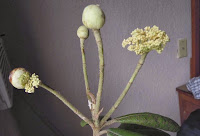Sommeras are tropical
shrubs or small trees belonging to the Rubiaceae (the same group as plants as Coffee) found in
tropical rainforests and occasionally dry Oak forests in Central and
South America. They typically have large fleshy leaves and small
flowers, and produce fleshy berries with numerous seeds.
In a paper published in
the journal PhytoKeys on 13 October 2015, David Lorence of the
National Tropical Botanical Garden in Kalaheo, Hawaii and Anke Dietzsch and Daniel Kelly of the Department of Botany at Trinity
College Dublin, describe a new
species of Sommera from the Parque Nacional El Cusuco in Cortes
Province, Honduras.
The
new species is named Sommera
cusucoana, in
reference to the park where it was discovered. It has large oval
leaves with long red stems, and produces inflorescences each
comprising 2-4 small, white tubular flowers, that give rise tolarge,
dark red berries.
Sommera
cusucoana. Tip of
shoot with flower, developing fruits, and leaf pair emerging between
pair of stipules. Anke Dietzsch in Lorence et
al.
(2015).
Sommera
cusucoana was
described from two small trees found a few meters appart in an area
of montane rainforest dominated by tall trees such as Liquidambar
styraciflua (American Sweetgum)
and Cedrela
odorata (Spanish Cedar).
The trees werea the bottom of a steep valley at an altitude of 1333
m, with a moist microclimate. The area is somewhat disturbed, being
close to campsites and trails used by visitors to the park, as well
as natural disturbances such as landslips and tree windfalls. The
location is only about 500 m from an area that was clear-felled by
loggers in 2010-13 (despite being deep within a national park), and
Lorence et al.
therefore
propose that the species be listed as Critically Endangered under the
terms of the International Union for the Conservation of Nature’s Red List of Threatened Species.
See also...
 Trying to save the Sinkhole Cycad. Cycads are an ancient group of
Gymnosperm Plants thought to be among the closest surviving relatives of
Flowering Plants. They originated in the Palaeozoic, and were once one of the
most abundant plant groups on Earth, but were almost wiped out at the end of...
Trying to save the Sinkhole Cycad. Cycads are an ancient group of
Gymnosperm Plants thought to be among the closest surviving relatives of
Flowering Plants. They originated in the Palaeozoic, and were once one of the
most abundant plant groups on Earth, but were almost wiped out at the end of... How the Piñuela affects soil communities in its native environment. The Piñuela, Bromelia pinguin, is a ground dwelling Bromeliad
widely farmed in Central America and the Caribbean both for its fruit
and its hedge forming ability. It naturally forms dense clumps spiney
growth, unusual in rainforests, where finding two plants of the same...
How the Piñuela affects soil communities in its native environment. The Piñuela, Bromelia pinguin, is a ground dwelling Bromeliad
widely farmed in Central America and the Caribbean both for its fruit
and its hedge forming ability. It naturally forms dense clumps spiney
growth, unusual in rainforests, where finding two plants of the same... A new species of Hydrangea from Mexico and Central America. Hydrangeas are perennial woody plants related to Dogwoods and
Silkleafs. Most species form small shrubs, but some grow to tree sizes,
and there are some lianas (woody vines) in the group...
A new species of Hydrangea from Mexico and Central America. Hydrangeas are perennial woody plants related to Dogwoods and
Silkleafs. Most species form small shrubs, but some grow to tree sizes,
and there are some lianas (woody vines) in the group...
Follow Sciency Thoughts on Facebook.

